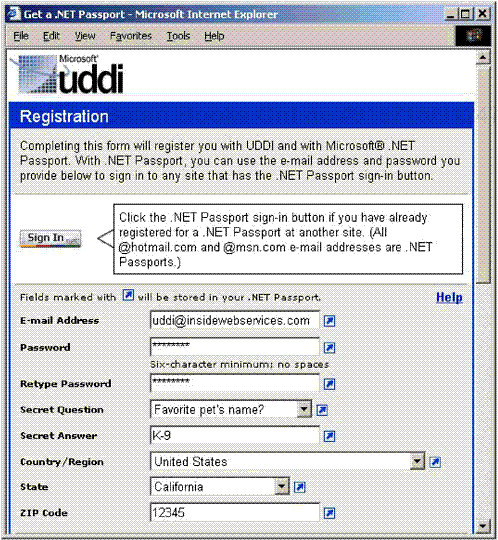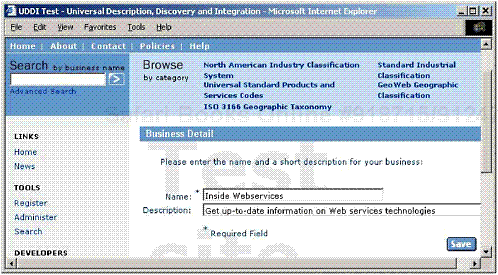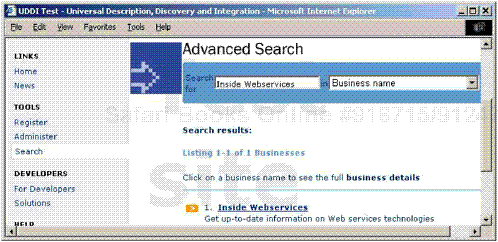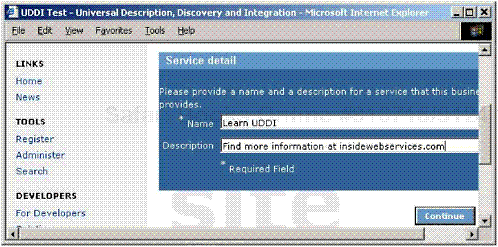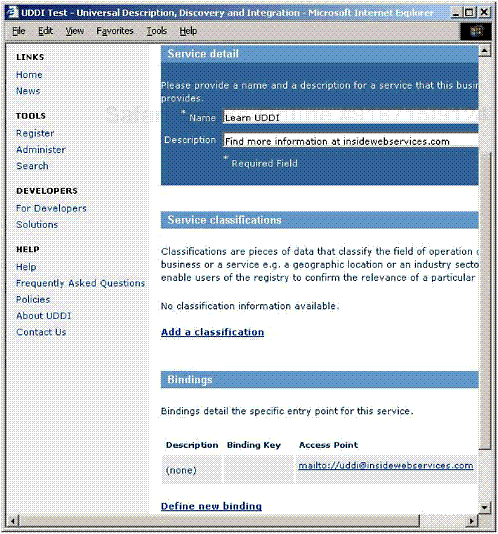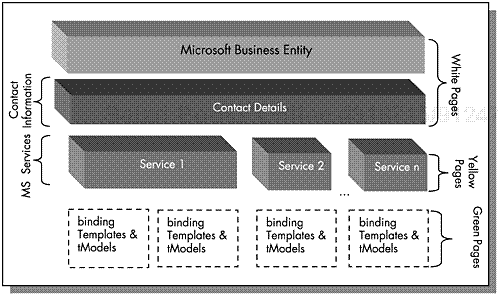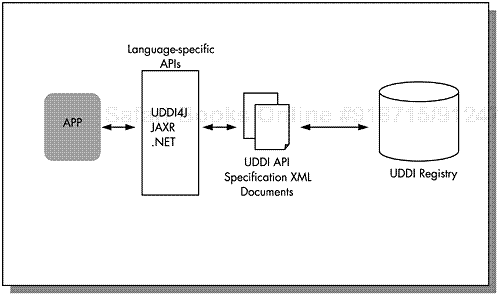The Universal Description, Discovery, and Integration (UDDI) initiative started as a project that brought several companies under one umbrella to discuss the issues related to business integration. Today, the UDDI forum has taken the form of a specification body as well as an entity that plays a vital role in the operational aspect of a UDDI site. The UDDI specification provides the Application Programming Interfaces (APIs) that businesses can use to interact with any UDDI site. On the other hand, the UDDI project deals with operational issues regarding deploying a UDDI business registry. As a result, the UDDI forum operates differently from a typical Internet “standards body,” such as the World Wide Web Consortium (W3C) or the Internet Engineering Task Force (IETF).
The UDDI initiative was announced on September 6, 2000 as a project that aimed at supporting a solution for service-centric business-to-business (B2B) integration issues. These issues are faced by any enterprise today when it integrates internally as well as with its partners and customers. UDDI provides the following direction for the project:
The UDDI Project is an open industry initiative in which any organization can participate and implement the specifications. The specifications build on core Internet standards — including TCP/IP, HTML, and XML — and are independent of any underlying platform, language, object model, business application, or marketplace.
The project also announced formation of an entity to oversee the functional aspects. This entity, UDDI.org, has three founding members — Ariba, IBM, and Microsoft. Today, there are over 300 participating members in this organization representing a broad set of industries including several companies such as ABN Amro, Accenture, BASF, Dow Chemical, Hewlett-Packard Company (HP), NTT Communications Corporation, Sabre Holdings Corporation, SAP AG, and Thomas Publishing. This broad-based participation will ensure that the specification is rich enough to satisfy the needs of a wide range of industries.
UDDI.org participants fall in two categories — Working Group members and Advisor Group members. The Working Group members are responsible for developing and publishing specifications and best practices. The Advisor Group, which is where most of the members participate, provides any appropriate comments and amendments. Today, the Working Group includes 15 companies.
The UDDI project revolves around making the promise of service-centric computing real and achievable so that more and more companies can take advantage of it. Many businesses today use the Internet as a means to reach their customers and suppliers in an effective way. Reaching new customers and integrating supply chains in real-time has been made possible by the reach and simplicity of the Internet-based communication medium. An Internet-based business model is a vital part of business strategy of these businesses.
The use of Internet (and World Wide Web [WWW]) today, however, is limited in several ways:
The number of companies (vendors and customers) a business would deal with is limited to prior knowledge about them within that business. Information about a new customer or vendor is obtained primarily through non-Internet means, such as advertising and marketing agencies, advertising campaigns in media such as television, radio, and other product promotion means.
For most of the existing customers and vendors, the information is typically limited to the contact information of key persons (email, phone, and fax numbers, etc.) within those organizations. This makes person-to-person communication easy, but does not help system-to-system interaction.
For a smaller list of existing customers and vendors, there is a system-to-system integration in operation using established B2B technologies. However, these implementations are one-to-one, custom, and largely nonrepetitive. This makes current B2B architecture cost-prohibitive for wide-scale use.
The potential of Internet-based business models is not fully exploited as a result of these issues. UDDI.org and the UDDI project aim at addressing these issues and provide specifications to various solution components that resolve them.
UDDI proposes to create a “directory of business services” that provides listings of services, applications, and other software components developed to facilitate intercompany communication at the system level. This directory, conceptually built on but smarter than the real-life Yellow Pages, can provide a standardized way to discover new business entities. It facilitates companies to describe their services at an API-level and at the business-process level so that they can be discovered by potential trading partners with compatible business models and processes. Once discovered, the trading partners can quickly form a system-level communication channel (along with human-level engagement) to affect the new partnerships rapidly. Eventually, this can lead to lowered barriers for a company to participate in the global economy.
The UDDI project members had planned to hand over the UDDI specifications to a standards body after the third revision. As per that plan, the ownership for the specification has been transferred to Organization for the Advancement of Structured Information Standards (OASIS) in 2002.
Several participants in the UDDI project have created a public UDDI infrastructure that will serve as the backbone for many of the UDDI-based efforts. These sites implement the most current UDDI specification and are available free-of-charge to UDDI developers. The companies owning these public sites are called UDDI operators. At the time of writing this text, there were three public UDDI operators. The operators and the Uniform Resource Locator (URL) for their respective UDDI public (live and test) sites are as follows:
IBM Corporation
Microsoft Corporation
Test site: http://uddi.rte.microsoft.com
SAP AG
Test site: http://udditest.sap.com/
Beside these operators, Systinet Inc. also provides a UDDI site, although it is not part of the overall public UDDI infrastructure.
Systinet Inc.
Note that the above URLs simply provide information about the UDDI site itself and cannot be used directly to programmatically register or find a business. The URLs used for programmatic access are provided at these sites. All test programs and applications should use the test sites.
The “public UDDI infrastructure” that is supported by the above three operators is the public instantiation of the UDDI specification. Together, these sites create a uniform view of all the businesses that are registered within UDDI infrastructure. This infrastructure is called the Universal Business Registry (UBR). The registries that are part of the UBR operate in unison, and are a replica of each other for basic registry information. It is possible to create UDDI sites that are not part of the UBR. As noted earlier, the Systinet UDDI instance is not part of the UBR.
Note
UDDI.org treats the UDDI API specification as an open standard. As such, the organization does not preclude the existence of non-UBR public instances of a business registry based on the UDDI specification. Of course, such registry instances will have some drawbacks such as not carrying the listings from the UBR. However, these instances can still play a role in providing value-added services that the UBR does not. There are also certain advantages for such registries, since they do not need to rollout functionality in a lock-step fashion—a requirement for UBR operators.
Any UBR site primarily provides basic functionality for a business to participate in the registry:
Register a UBR user
Register a business entity within the UBR
Register a service or a set of services that belong to a specific business entity
Register a service interaction model
Register a service binding
Discover or browse a business or a service using certain search criteria
While the UBR sites are meant to be used, primarily, in a programmatic way, all UBRs provide browser-based interactivity. This can be used to explore UDDI functionality. In Section 5.2.2, we discuss general UBR functionality using Microsoft’s UBR instance. Other UBRs provide similar functionality as well. Typically, the browser-based functionality is a subset of overall programmatic functionality.
The Microsoft UBR instance can be used for registering, discovering, and browsing a business or a service. Anyone can browse (look up information in) the UBR, but in order to add information to the registry the user must first register as a publisher. The registration is based on Microsoft Passport service. The URL https://uddi.microsoft.com/register.aspx provides user registration which is based on an email address. Figure 5.1 shows the registration of the email address: [email protected]. Note that the email address provided must be a valid email address. Registration cannot be completed until the email-based step is completed.
After successful registration, an email is sent to the email address and the user can provide additional information such as username. Clicking on the link provided in the email completes the registration process. To verify successful registration, login at the Microsoft UDDI site.
A registered user can add a business entity within the UBR. Business entity registration consists of providing details about the company it represents. To register a business entity, click on the add business link after user login. Figure 5.2 depicts the registration for a business — Inside Webservices.
Business registration typically includes the name of the business as well as a free-formatted string description. The description for Inside Webservices is “Get up-to-date information on Web services technologies.”
Upon successful registration of a business, several new options to register services and other business attributes appear as shown in Figure 5.3. The user must click on the Publish button to publish the business to the site. This process includes validation and usually takes less than a day.
Any user can discover any business registered with the UBR. This includes the businesses registered by other users as well. Figure 5.4 depicts the discovery of the business entity Inside Webservices. Figure 5.5 shows the successful discovery of the business. Note that this search is case-insensitive and that wildcard searches are supported. The underlying UDDI APIs provide both case-sensitive as well as case-insensitive search mechanisms.
A successful business discovery is presented with a URL for the found business entity. Clicking on the link takes us to the information about the business entity as shown in Figure 5.6.
The information provides several key data items about the discovered business.
Examples of this key data are the name of the business, any contact information, if added, and the field Business Key.
Every registered element, such as a business entity, a service, or a service interaction model, in a UDDI registry is assigned a universally unique identifier (also called a UUID). The Business Key shows the UUID for a business. The UUID for the business Inside Webservices is: 735F7664-930F-4D8C-80A6-0A9B154162A3. A UUID uniquely identifies any element in the UBR infrastructure. The UUID key for a service is called Service Key. This mechanism ensures that UBR-registered elements can be uniquely addressed during discovery and interaction.
Regardless of which element is being assigned a UUID key, the underlying concept for all of them is the same. A UUID is a 128-bit value that is either guaranteed to be unique or extremely likely to be unique until 3400 A.D., based on the choice of algorithm. One advantage of the UUID scheme is that it does not require a central authority to generate the keys. Hence, it is a very attractive scheme to allocate unique identifiers in a distributed environment such as the UDDI UBR. UDDI has adopted the 8-4-4-4-12 Hex representation of the UUIDs.
Note
The UDDI Operator Council does not mandate any specific algorithm for generating UUIDs. However, if required, it may review the algorithm used by a UBR participant. Several UUID generation algorithms are described at:
http://www.ics.uci.edu/pub/ietf/webdav/uuid-guid/draft-leach-uuids-guids-01.txt
The successful search of a business entity also provides a discovery URL that can be cached for future reference. Clicking on that link returns the full UDDI XML representation of the business entity it represents. Some of the information fields shown are private to the entity that registered it (registration owner). This information is not publicly visible.
Once a business entity is registered, services can be added to its portfolio. One business entity can register several services. Figure 5.7 shows the registration of the service Learn UDDI under the business Inside Webservices, while Figure 5.8 depicts successful service registration. Note the additional information such as the service classification and binding that is maintained within the UDDI registry.
The service registration so far concentrates only on certain informational elements such as name and description. However, for the registration to be useful, the information to access the service is also necessary. Such service bindings can be used to interact with the service using the appropriate communication protocol.
In UDDI terms, such a binding is called a bindingTemplate. BindingTemplates denote access points for registered services. For a service, there could be several access points possible. For example, a service might be accessible via email, through a Web page, or via the File Transfer Protocol (FTP). Figure 5.9 shows how to add a binding for a service. In this case, a mailto binding is added to the service Learn UDDI.
These are the minimum steps required to list a service in a UBR. Advanced features provided by the UBR are discussed throughout the book.
A company interested in joining the UDDI community can register itself and its services in the UDDI registry. In Section 5.2.2, we discuss a simple example to do that. Usually, a fair amount of technical and business expertise is needed to register a complex business and its service portfolio. While it is possible for some companies to have the necessary expertise in-house, several companies may not have it. This could potentially slow down the adoption of UDDI.
To address this issue, a class of companies, called UDDI Registrars, has emerged. A UDDI registrar is a company that can perform the registrations on behalf of other companies. A registrar acts as a “consultant” to a company or business that wishes to list itself and its services in the UDDI registry. Such consulting would typically include:
Compiling business information
Defining the list of services to register
Determining the models that describe those services
UDDI registrars are functionally analogous to companies such as Register.com, Inc. (http://www.register.com). Register.com provides the basic services required to register a new Internet domain with the Internet Corporation for Assigned Names and Numbers (ICANN) — the corporation that oversees the management of the Internet domain name system. Besides the domain name registration, Register.com also provides other value-added services, such as domain hosting and Web page designing, through its partners.
There are several companies that are currently acting as UDDI registrars. Promi-nent among them are Peregrine Systems and Riskebiz Internet Services Inc. In the future, more companies are likely to play the role of registrars as UDDI becomes more popular among businesses worldwide.
The entire UBR functionality is based on the infrastructure created and maintained by the UDDI operators. For smoother operation of business registrations and discoveries, uniform operating procedures are essential. Becoming a UDDI operator thus requires adherence to several operational standards — those that are generally applicable to any Web site with high availability demands, as well as those that are specific to UDDI. As a result, there are only a few operators that form the UBR cloud.
To bring uniformity among various UDDI operators, and to ensure high availability of the UBR, the UDDI project has defined a specification for potential UDDI operators. The UDDI Operator’s Specification provides the details on several operational aspects of the UDDI registry instance. Some important aspects of this specification are:
Directory information management (storage, updates, and deletions)
Security (data replication and management, approved Certificate Authorities)
Inter-operator data replication requirements
Custody transfer (protocol for transfer of a business account from one operator to the other under various scenarios)
The operator council is comprised of the UBR operators. This group deals with the operational aspects of the UBR — such as uptime, compatibility, and interoperability. The council owns the UDDI Operator Agreement that defines the stipulations that all UBR operators must abide by. It also administers the UBR testing plan. This plan ensures that all UBR sites operate cohesively as part of the UBR cloud. A secondary purpose for the UDDI Operator Council is to be the first implementer of the specification and provide feedback to the UDDI Working Group. This feed-back not only adds to the over all quality of the current specification, but also guides future versions.
As described in Section 5.2.2, it is possible to interact with a UDDI registry through a set of Web pages. Indeed, these Web pages simplify interacting with UDDI and in some cases are sufficient for some businesses. For example, it is possible for a small bakery owner (who does not have any dedicated computing infrastructure on site) to search for a paper company that can provide a certain type of paper carton suitable for packaging products. Once the shop owner discovers an appropriate paper company, through browser-based interaction, business interaction can continue through traditional means such as phone, fax, or simply on paper.
For some businesses, however, this may limit the interaction with the registry. Admittedly, browser-based interaction constricts the user to conduct a search or a service registration to the features provided on the Web page. Consider, for example, performing spell-check on the service description. This feature will most likely be absent from the Web pages at an operator site. UDDI provides Programmer’s API Specification to develop custom-built tools based on customer needs.
The UDDI API specification is slightly different from other API specifications. One of the chief design principles used in UDDI is to keep it accessible to any business system — regardless of the underlying platform. Because of this, registry is available to any applications written in virtually any language — from COBOL to C#. This goal can be achieved through a different programming model called Document Exchange Model (DEM).
A programming language provides the means to communicate data among various components of an application. The most commonly used mechanisms are passing parameters through function calls and object serialization. Technologies such as Common Object Request Broker Architecture (CORBA) also facilitate data communication between objects that are deployed across different computers — a technique called Remote Procedure Call (RPC). This type of programming model is called Network Object Model (NOM).
The DEM programming technique is different from NOM. It models the interaction between two “objects” as an exchange of a series of structured text documents, rather than chunks of data laid out in some language-specific format.
The DEM-based application design has several advantages over their NOM-based counterparts. Since a structured document can be parsed and understood by virtually any language, it is possible to facilitate interaction between any two objects (or applications) written in potentially incompatible languages. Table 5.1 provides comparison between the two techniques.
Table 5.1. Comparison Between NOM and DEM Programming Models
|
Network Object Model |
Document Exchange Model |
|---|---|
|
Supports tightly coupled architecture |
Supports loosely coupled architecture |
|
Suitable for programmatic interaction |
Suitable for document-based interaction |
|
Objects have state and behavior |
Documents are stateless |
|
Mostly suitable for short-lived interaction |
Mostly suitable for long-lived interactions |
|
Interface definition language (IDL) defines interaction interface |
Document schemas and metadata define interaction interface |
|
Code level method binding |
Agreement on document semantics rather than interfaces |
|
Uses language-specific protocols |
Uses language-independent protocols |
|
Works best in intranet environment |
Can work in both intranet and Internet environment |
As can be seen from this comparison, the DEM programming model is more suitable for intercompany interactions that are normally long-lived (completed over a long period of time) and happen across multiple firewalls on various platforms. At the root of the DEM model is a structured document. The extensible Markup Lan-guage (XML) has become a de facto standard for creating such documents.
The UDDI programming APIs are essentially the XML schemas for interacting with the UBR. Unlike typical programming APIs, the UDDI APIs provide the schemas for XML-based request and response documents. These APIs dictate how the XML document should be formatted to interact with the UDDI registry. For example, here is the syntax of the find_business API that is used to discover a business that matches certain criteria.
<find_business [maxRows="nn"] generic="2.0"
xmlns="urn:uddi-org:api_v2" >
[<findQualifiers/>]
[<name/> [<name/>]... ]
[<discoveryURLs/>]
[<identifierBag/>]
[<categoryBag/>]
[<tModelBag/>]
</find_business> We discuss individual tags such as categoryBag in greater detail in Chapter 7–9. However, at this point, it is important to note the nature of the UDDI APIs. These APIs also require that the XML document is, in fact, sent as a Simple Object Access Protocol (SOAP) message. The SOAP technology, which facilitates the RPC mechanism in the DEM world, is conceptually much the same as the traditional RPC mechanism in the NOM paradigm. Appendix G provides a summary of SOAP technology. The UDDI API specification further stipulates that the SOAP message be sent over the Hypertext Transfer Protocol (HTTP). Thus, the SOAP message over HTTP forms the fundamental transport protocol for any UDDI related interaction. A UBR instance, hosted by any operator, can understand and will respond in only a SOAP encoded message over HTTP.
The UDDI API specification has undergone changes as more and more functionality is added and changes are made to existing APIs. The first specification Version 1.0 was released in September 2000. The Version 2.0 specification was released in June 2001. The UDDI Working Group released the Version 3.0 specification in July of 2002.
This book deals primarily with the Version 2.0 specification, since that is the specification implemented by all existing UBR instances. Discussion of Version 3.0 has been included in Chapter 14.
The UDDI APIs are classified in two main categories:
Inquiry APIs
Publish APIs
The Inquiry APIs, as the name suggests, are APIs used for querying a UDDI registry. The query can be used to discover either a business or more specifics about services offered by a specific business. The Publish APIs, on the other hand, are used to publish information about a business or its services.
The information published about a company (and its services) is at the center of effective participation of that company. The Inquiry APIs search the published information in order to return the appropriate businesses or services. Thus, registration owners must ensure sufficiency and accuracy of registration information. Registration information can be categorized in three ways:
White Pages
Yellow Pages
Green Pages
This type of categorization can be likened to their namesake in a phone directory.
Information that is largely contact information about a company forms the White Pages category. This includes information such as the name of the company, its phone number and address, and any known company identifiers such as the DUNS number. The White Pages are analogous to a CORBA interface repository.
The Yellow Pages section delves into the services offered by a company. Because a company can offer several services, multiple Yellow Page entries may be found within a business — one set per service. Yellow Pages are equivalent to a CORBA trading service.
The Green Pages are a different category in the sense that they do not have a namesake in the phone directory system. The Green Pages section provides technical information about the services exposed by the companies. This technical information can be used by any user to interact with the exposed service. Green Pages can provide information about which standardized protocols or specifications a specific service abides by, so that its users can adjust their interaction sequence accordingly. Green Pages are analogous to a CORBA implementation repository.
UDDI defines a special metadata construct called tModel to describe the specifications that a service abides by. Each tModel corresponds to a certain specification (or version thereof) and thus is related to specific interaction interface (or interfaces) as mandated by that specification. Using the tModel associations of a service — called tModel bindings — a user of a service can readily determine the sequence of actions it must take to be able to communicate with the service. Conversely, it is also possible for a service user to narrow the search for a suitable service to only those services that support the tModels that the user understands. For example, a company may choose only those vendors that abide by the Roset-taNet [1] standard during the order fulfillment processes.
The concept of a tModel is a very radical way of reducing the time required to ensure compatibility between a service and its users. tModels provide a common reference point for development teams across companies. They also can ease discussions regarding information flow between ecosystem entities. We discuss tModels in more details in Chapter 6.
Table 5.2 provides a summary of the three different levels of information. It is also important to note the relationship between the three information sets and how they are related.
Table 5.2. White, Yellow, and Green Pages in Perspective
|
White Pages |
Yellow Pages |
Green Pages |
|---|---|---|
|
Business name Contact information Text Descriptions Identifiers |
Services Product indexes Geographic indexes Industry codes |
Service descriptions Business processes tModel Bindings |
The Microsoft UBR provides an excellent example to bring out the relationship among these three information sets. It has published information in all these areas for the business entity “Microsoft Corporation.”
The business entity Microsoft Corporation, is already registered at the Microsoft UBR site and is discoverable by any user. Figure 5.11 depicts the organization of this business entity.
The business entity is the overarching element that has several elements, such as services, registered underneath. The business entity and the contact information form the White Pages section. The services themselves are part of the Yellow Pages category. Information pertinent to the Green Pages section, such as bindingTemplates and tModels, can also be found wherever applicable. For example, look at the Home Page service. The registered information is as follows:
Service Name: Home Page
Service Key: 17b29861-2f33-402c-98f0-fd16cf5b8e9c
Service Binding: http://www.microsoft.com
tModel Info: uddi-org:http
Participation in a UDDI registry raises many design considerations such as:
The type of information a business should expose about itself
The structure of services and subservices
The tModel or tModels to comply by
It is easy to see that there are several ways to register a business and its services on a UDDI registry, both from an architectural and a design point of view. The UDDI project addresses such issues by releasing Best Practices papers. For example, it addresses the question “What is the best way to model a suite of services that a business wants to expose to the outside world?” These guidelines, compiled together, provide a set of design templates that can be used during design phases. These guidelines are called Best Practices.
The UDDI project Web site provides an easy reference to the best practices documentation. The current set of guidelines is somewhat rudimentary in nature, but as UDDI matures, several additions to this compilation can be expected. These best practices are used throughout this book.
The complete UDDI ecosystem consists of several entities that are necessary for UDDI-based interactions to work seamlessly. Figure 5.12 depicts the ecosystem of UDDI registry players and the relationships among them.
UDDI.org provides the foundation of this ecosystem with the API and operator specifications as well guidelines for designing services that use the registry. The UBR operators, such as Microsoft, create the public instantiation of the UDDI registry, while individual companies can create their own private registry instances. Standards bodies are responsible for defining tModels necessary for uniform interactivity across services in the same domain or functionality. Registrars provide the service registration expertise. Vendors and service providers can register their services by using such registrars. Together, these ecosystem members create an environment that can be used to discover the best services to meet their needs.
As described in Section 5.4.1, the UDDI API specification describes how to interact with a UDDI registry using XML documents. While this helps in bringing the language-independence necessary for widespread adoption, it does pose one limitation.
While structured documents, such as XML documents, are easy for computers to understand, human beings cannot process them well. Constructing or editing an XML document is a tedious and error-prone job for a person. Thus, it would be difficult to author an XML document that represents a find_business query and then decipher the XML response from the registry. For that, a user interface, such as a Web page or form, is necessary.
The need for a suitable user interface automatically implies the need for a programming language. To facilitate interaction between the user interface with a registry, a set of APIs are needed. For easy interoperability, these APIs should preferably be in the same programming language in which the user interface or any business logic is written. This need has given rise to several language-specific UDDI APIs. We describe some of the most common APIs. Figure 5.13 shows the relationship between language-specific APIs and the UDDI APIs. The language-specific APIs manage the XML communication for the application layer.
UDDI4J provides a set of Java APIs to interact with a UDDI registry. It is not the only Java API available today, but it is likely to be a dominant API due to endorsement from IBM and HP. The UDDI4J is an ongoing open source project. The programming examples provided in this book primarily use the UDDI4J APIs. We discuss these APIs in more detail in Chapters 7–9.
The Java community also provides an answer to the need for Java APIs for a UDDI registry. The Java APIs for XML Registries (JAXR) effort, however, is an overar-ching initiative that aims at providing a uniform set of APIs for all XML registries including UDDI and ebXML. The JAXR APIs are currently available as an early access release.
The .NET framework, announced and championed by Microsoft, provides support for the UDDI initiative. The .NET platform provides the Microsoft UDDI .NET SDK that helps in building UDDI client-side components using the .NET technology. The SDK provides APIs for languages that run in the .NET runtime.
While the UDDI registry can be used to register any services, it has been developed primarily with Web services in mind. Thus, to effectively use all the features available in UDDI, a good understanding of Web services technology is helpful. A complete in-depth discussion on Web services is beyond the scope of this book. In the next chapter, we provide a brief overview of the Web services concepts and the technologies used to develop them.
[1] RosettaNet is a consortium of more than 400 worldwide companies dedicated to creating, implementing, and promoting open e-business standards. These standards form a common e-business language, aligning processes between trading partners on a global basis.

